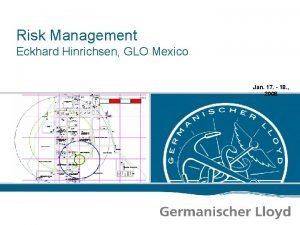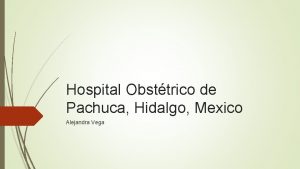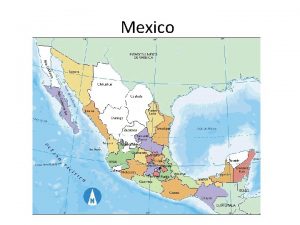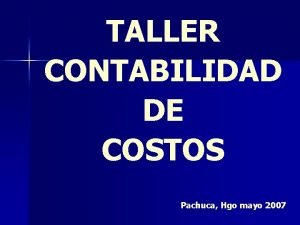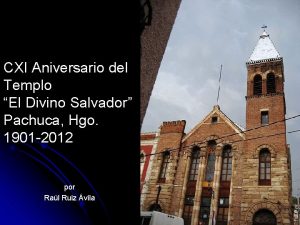Summer Clinical in Pachuca Mexico Thomas J Stolz












- Slides: 12

Summer Clinical in Pachuca, Mexico Thomas J Stolz Jr

Areas of focus 1 2 Gain an understanding of the Mexican healthcare system as it compares to the American Healthcare System Work on clinical Spanish • Focus on the Emergency setting • Focus on patient interview 3 Improve clinical skills through hands on approach

Clinical Rotation site: Pachuca, Mexico Capitol of the State of Hidalgo (3 Million population).

UAEH

Medical education in Mexico • 4 years education • 2 years of didactics, but much more clinical in first years • 2 years of rotations • 1 intern year • 1 social service year • After social service Doctors can become general practitioner or pursue a residency

Hospital General de Pachuca • Hospital funding and patient population • Secretariat of Health’s Seguro Popular – Funded by federal government • Unemployed • Clinical experience • Most busy hospital • 16 beds in the open trauma room • 40+ more patients in hallway • Lack of basic supplies • Worked in Emergency • Clinical Highlight • Running compression on coding patient • Auscultation of pneumonia • Placing NG tube

IMSS Hospital • Hospital funding and patient population • Instituto Mexicano del Seguro Social - Funded equally by the employee, employer and the federal government • Employed citizens • Clinical experience • Significantly nicer than public hospital • Medication and equipment more readily available • Separate areas for trauma and critical care • Worked in Emergency • Clinical Highlight • Stitching up patients hand post crushing accident • Rhabdomyolysis case • Severe gangrenous infection wound cleaning

DIF Hidalgo – Hospital del nino • Hospital description • Completely government funded. • Children • Clinical experience • By far the nicest hospital • EMR • Worked in Peds onc / Surgery • Clinical highlight • Identifying a case of Intussusception by Ultra sound imaging • Participating in Ileum anastomoses

Mexico vs USA Comparisons % population with health coverage Predominant form of health coverage % GDP used on health coverage Life expectancy All cause mortality (per 100, 000) Number of Doctors per 1000 Mexico United States 92. 3 % 90. 9% Government-funded Private Insurance 6. 2% 16. 4% 74. 4 years 78. 8 years 946. 1 (#34 of 34) 826. 1 (#27 of 34) 2. 2 2. 5

Top causes of Death (Mexico) Cause Percent Diseases of the heart 16. 0 Diabetes mellitus 14. 5 Stroke 5. 5 Interpersonal violence 5. 4 Cirrhosis of liver 4. 1 COPD 3. 8 Lower respiratory infection 3. 4 Hypertensive heart disease 3. 4 Road injury 2. 5 Nephritis, nephrotic syndrome and nephrosis 2. 3

Top causes of Death (USA) Cause Percent Diseases of the heart 23. 4 Malignant Neoplasm 22. 5 Chronic lower respiratory diseases 5. 6 Accidents (unintentional injuries) 5. 2 Cerebrovascular diseases 5. 1 Alzheimer's disease 3. 6 Diabetes mellitus 2. 9 Influenza and pneumonia 2. 1 Nephritis, nephrotic syndrome and nephrosis 1. 8 Intentional self-harm (suicide) 1. 6

Final observations • • Clinical guidelines of practice are comparable between US and Mexico. However major differences seen were: • Practitioners are much more lax with their decision making and following EBM • Lack of EMR makes tracing of medical malpractice much harder • Lack of adequate supplies makes care much more difficult in certain settings • Lack of equipment (CT, MRI) makes Mexican practitioners much more dependent on clinical skills
 Erika stolz
Erika stolz Julio has fragmented thinking
Julio has fragmented thinking Forensic pathologist vs forensic anthropologist
Forensic pathologist vs forensic anthropologist Mexico terrain
Mexico terrain Countries that border mexico
Countries that border mexico Vem china
Vem china Biografia de john kenneth turner
Biografia de john kenneth turner Mexico en la piel xcaret
Mexico en la piel xcaret New mexico amp
New mexico amp Proper adjectives for countries
Proper adjectives for countries Canal 11 mexico
Canal 11 mexico Glo mexico
Glo mexico Tipos de generos dancisticos modernos
Tipos de generos dancisticos modernos











